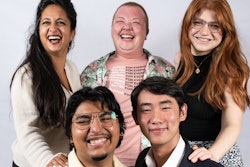Building culturally validating and affirming relationships between teachers and students requires plenty of understanding, engagement, changes in behavior, and introspection, according to a webinar held Tuesday by the Equity Assistance Center-South. Victoria McCall
Victoria McCall
The webinar gave a platform to Victoria McCall, director of eLearning at The Center for Black Educator Development, to provide ample advice and instruction on how educators can better forge strong and positive relationships with the people they serve.
Foundational to these relationships is trust, which may not be freely and equally given by different communities due to historical oppression, leading some to view educational institutions as part of the state, McCall said.
“Those from oppressed communities see educational institutions, school buildings, district centers, as either representative of an oppressive government or as oppressive forces themselves,” she said. “And therefore, what happens is, we have to come to understand that trust-building has to be an intentional, well-thought out, practiced, and research behavior.”
She presented her audience with four strategies on how to build quality relationships in classrooms and workplaces. The first, she said, was to understand that there are cultural differences between people and to accommodate for those differences.
McCall explained that different people may be familiar with different “cultural archetypes,” such as collectivism and individualism.
“If a person's cultural practices are in conflict with the classroom or the workplace, they're the ones who must make the adjustments between home, school, and work,” McCall said. “Therefore, those who come from a more collectivist cultural framework are left to figure out how to accommodate those spaces. And it should not be left to them.
“This lack of sense of belonging and the lack of culturally affirming spaces is a top reason why teachers of color leave the profession.”
She said that it was important to authentically engage with and foster trust within the community one serves in by getting to know local people, using public transit, and shopping locally.
“Increasing engagement – whether that's through connection, shared experience, proximity – all of those build trust ... which then allows you to move in a space of validating and affirming cultural difference,” McCall said.
Language and environment, she added, are also important mediums through which strong relationships are built. Educators can work to both validate – make acceptable, affirm, portray as positive – people’s different cultures and identities through policy, imagery, and practices that counter negative narratives heard elsewhere.
Changing dress code rules so that students can wear their hair however they would like and displaying diverse and ethnic art are but some examples of how to validate and affirm, McCall said.
“These all need to be authentic. We do not want to toe the line of culturally appropriating someone else's ethnic printworks, artworks, and textiles,” she said. “One of the best ways to do that might be to either shop locally [or] ask local questions.”
Additionally, using vocabulary such as “respect” and “appreciate” instead of more neutral words such as “tolerate” and “allow” can be helpful in building validating relationships, she added.
Lastly, when one tries to do better and build these relationships, there’s always a possibility of making mistakes – an educator might find themselves berating a Black student while going easier on a lighter-skinned one.
To McCall, what’s crucial is being willing to repair what’s broken afterwards.
The perpetrator must acknowledge their error, process how they had acted, and examine what personal biases may have led to such behavior. It is key that these steps take place internally or not involve the affected party, McCall said. The goal is not to burden harmed individuals further.
“Marginalized community members are often taxed with the additional labor of helping people process the harm that has been done to them, which exacerbates the harm,” she said.
The perpetrator can then request to meet, apologize, and commit to improving.
Dr. Robert Teranishi, a professor of social science and comparative education at UCLA, said in an email that trust and respect between students and schools are critical because education is inherently relational. Educators will do well to also consider students’ parents, he added.
Representation among educators matters as well, according to Dr. Frank Fernandez, an associate professor of higher education administration and policy at the University of Florida.
“Part of what [building trust] looks like is ensuring that teachers and school leaders should look like the communities they serve,” Fernandez wrote in an email. “It’s not just a feel-good idea. There have been rigorous statistical studies that show that diverse students do better when they have teachers who share their backgrounds (e.g., girls in math and science; students of color in K12 and higher education).”





















